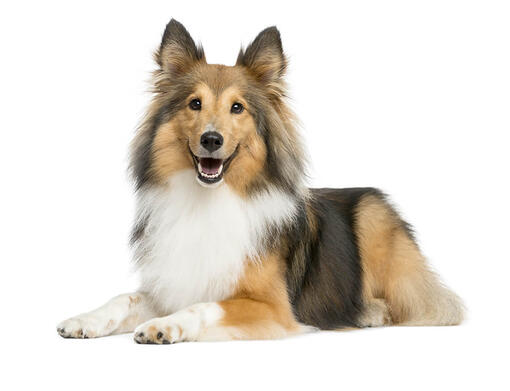
Known as a devoted and docile dog with keen intelligence and understanding, the Shetland Sheepdog is one of the most successful obedience breeds. This rough-coated, longhaired herding dog descended from the Border Collie of Scotland. Intensely loyal, affectionate and responsive, the Sheltie is an excellent family dog. He thrives on farms but adapts to many living situations if provided adequate exercise. His dense double coat requires regular grooming.
DID YOU KNOW? The Sheltie is one of the most successful obedience breeds.
ALSO KNOWN AS: Shetland Collie, Dwarf Scotch Shepherd, Toonie dog
The need-to-know
- Dog suitable for owners with some experience
- Basic training required
- Enjoys active walks
- Enjoys walking one to two hours a day
- Small dog
- Some drool
- Requires grooming daily
- Non hypoallergenic breed
- Quiet dog
- Guard dog. Barks and alerts
- May require training to live with other pets
- May require training to live with kids
Personality

The Sheltie may look every inch the show dog, and these days many are, but under the glorious coat, there is a strong, active working breed with a sharp mind and bags of energy. Devoted to their owners, Shetland Sheepdogs can take a while to warm to strangers, and they are never off duty – always ready to alert their owner to whatever catches their eye!
History and Origins

Country of Origin: Shetland Isles
Named for the Shetland Isles off the North-East coast of Scotland where this breed was developed, the Shetland Sheepdogs original job was aiding crofters in herding sheep, and protecting unfenced crops from anything that fancied a free meal. Many animals native to Shetland are notable for their smaller stature - the sheep and ponies in particular. As a result, crofters had no need of a large, expensive to feed working dog when a nimble smaller dog would do better.
Nutrition and Feeding

Small dog breeds, such as the Shetland Sheepdog, have a fast metabolism, meaning they burn energy at a high rate, although their small stomachs mean that they must eat little and often. Small-breed foods are specifically designed with appropriate levels of key nutrients and smaller kibble sizes to suit smaller mouths. This also encourages chewing and improves digestion. Discover more about how to offer your dog a balanced diet with our easy-to-follow guide.
Exercise

This is a dog who will need at least an hour of dog exercise daily, with plenty of variety in walking route and free running in secure places. The Shetland Sheepdog has a busy, active mind as well as an athletic body, so plenty of mental stimulation will be necessary to keep them occupied. This is a dog who enjoys training and will do well in dog sports, particularly agility, obedience and flyball.
Other Information

Health and common concerns
As with many breeds, the Shetland Sheepdog can suffer from various hereditary eye disorders, and hip dysplasia (a condition that can lead to mobility problems). Eye testing and hip scoring of dogs prior to breeding is therefore important.
Space requirements
Economical to house and transport, the Shetland Sheepdog has no dramatic requirements here, but a quiet house away from close neighbours or busy overstimulating traffic sounds would be best. The Sheltie takes the job of alert dog very seriously, and is known to be vocal, so not ideal for flats or terraced housing. Plenty of access to a variety of rural walks is a must, and space to groom and dry off that heavy coat will be necessary.
Training shetland sheepdogs
Quick to learn, the Sheltie is a bright little dog who will thrive with an owner who enjoys dog training and sports. Able to learn anything a dog of this size can physically do, the Sheltie will benefit from learning to be quiet when asked and willing to settle down and wait, as these will be the areas they struggle with. Go-go-go is not a problem. Stop and shush might be!
Best family dog breeds
The Shetland Sheepdog is probably better suited to a more mature family with older children, or without children. Their busy, active minds and fast learning ability, whilst excellent in some respects, means they can be easily over-stimulated and learn the wrong things particularly around very small children. While many dogs are traditionally thought of as being good with children, all dogs and children need to be taught to get on with each other and be safe together. Even so, dogs and young children should never be left alone together and adults should supervise all interactions between them.
Did you know?
- Whilst there have been many ‘presidential dogs’ residing at the White House, it was President Calvin Coolidge who had, for the benefit of his Shetland Sheepdog ‘Calamity Jane’, a special dog bath built, to keep her coat clean and sweet smelling.
- More recently, popstar Miley Cyrus has a Sheltie called Emu whose portrait she has had tattooed on her arm.